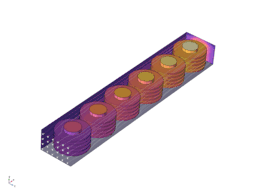
Nerve Smart Systems is an ambitious innovative company located in Roskilde, Denmark.
Nerve Smart Systems delivers High Power Charging with up to 350 kW anywhere, regardless of the power grid’s capacity. They do this by taking advantage of the periods when the chargers are idle to charge a super-efficient battery that delivers power as fast as ANY vehicle can handle it.
This enables High Power Charging in areas with poor grid quality and optimizes the use of cheap and sustainable energy for the benefit of the planet and the climate. Nerve Smart Systems bases its products on the in-house developed semiconductor-based switch device called “Nerve Switch®”.

Safe operation and temperature control
High temperatures can cause the battery to degrade quickly or even cause a thermal runaway. Both safety and the performance of a battery can be improved by keeping it within a certain temperature range by dissipating the heat that is generated during the electrochemical processes in the cells. This allows the battery to operate safely and efficiently.
Collaboration and model development
resolvent worked collaboratively with Nerve Smart Systems sparring on the design and developing the COMSOL Multiphysics simulation models, which were needed to perform relevant CFD analysis on the battery module, guiding the development and decision-making of the air-cooling design.
Simulation approach
The project aimed to improve the cooling efficiency of existing flow channel design and therefore resolvent developed the relevant models to run Heat transfer simulations with various flow rates and different standoff (heat sink) designs.
Heat Transfer and CFD Analysis
The air cooling of a battery module was simulated using a conjugate heat transfer analysis, which models the heat transfer between solid and fluid domains by exchanging thermal energy at the interfaces between them.
The CFD analysis was initiated with the design optimization of a single standoff by varying the number of fins and spacing between them. The standoff size was constrained by the space availability in the battery module. The flow requirement and associated pressure drop in the battery module were calculated for different standoff designs. The results can be used to identify a cooling fan that provides the required flow rate and static pressure.
Outcome and learnings
The outcome of the simulation was the temperature distribution within the battery cells and the pressure drop in the system for different flow rates. The results were ready to use for choosing a cooling fan that provides the required flow rate and static pressure.
Future designs and the ability to compare several scenarios
The developed models can also provide flow requirements and pressure drop associated with different standoff/heatsink designs, which can be used to identify a suitable standoff design while implementing another flow channel configuration. Analysis was run to find the optimal air flow rate required to keep the battery cells below a certain temperature.

Qualified insights and data-based decision-making
The collaborative workflow between Nerve Smart Systems and resolvent allowed for smooth knowledge sharing and brought together important product know-how with modelling expertise. The COMSOL Multiphysics models developed can be utilized for future optimizations and modifications, and the insights gained from the simulation analysis can lead to design improvements and development.
Overall, our collaboration with Nerve Smart Systems demonstrates the importance of utilizing simulation analysis to optimize system performance and achieve product goals.